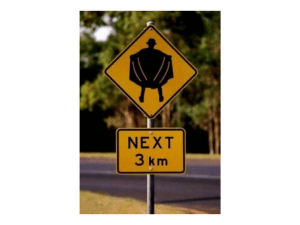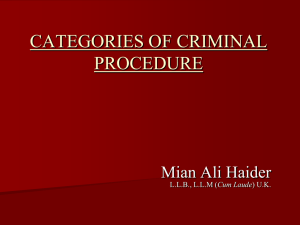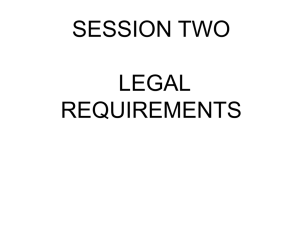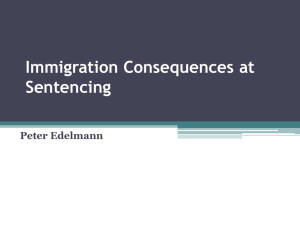strategic decisions in environmental prosecutions
advertisement
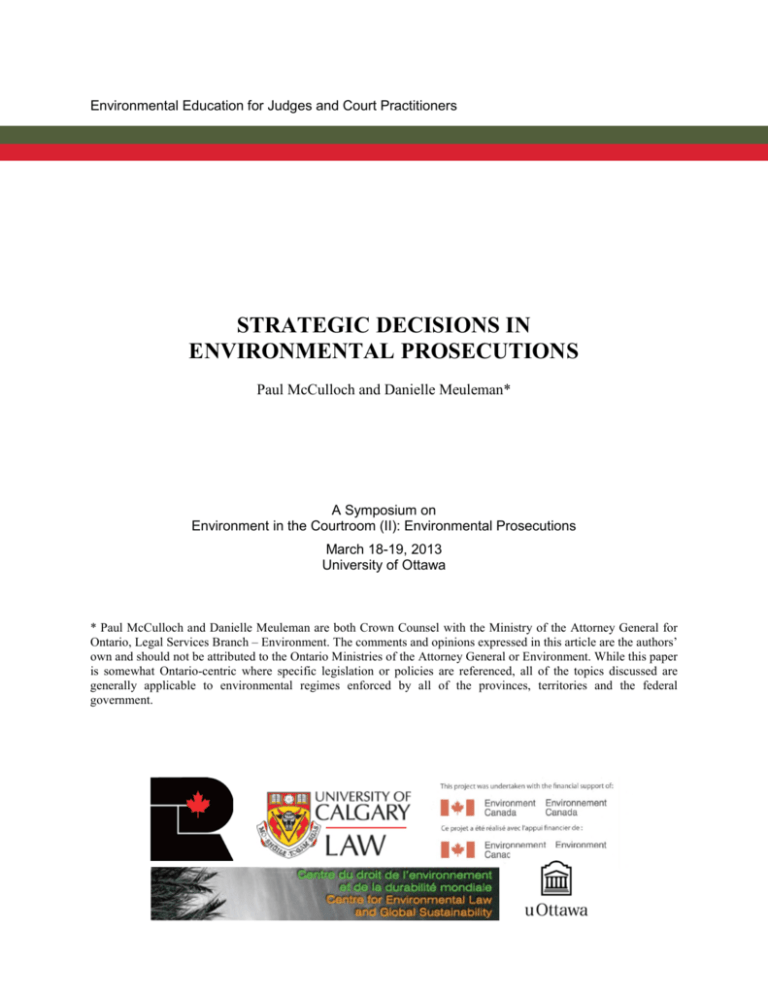
Environmental Education for Judges and Court Practitioners STRATEGIC DECISIONS IN ENVIRONMENTAL PROSECUTIONS Paul McCulloch and Danielle Meuleman* A Symposium on Environment in the Courtroom (II): Environmental Prosecutions March 18-19, 2013 University of Ottawa * Paul McCulloch and Danielle Meuleman are both Crown Counsel with the Ministry of the Attorney General for Ontario, Legal Services Branch – Environment. The comments and opinions expressed in this article are the authors’ own and should not be attributed to the Ontario Ministries of the Attorney General or Environment. While this paper is somewhat Ontario-centric where specific legislation or policies are referenced, all of the topics discussed are generally applicable to environmental regimes enforced by all of the provinces, territories and the federal government. The Canadian Institute of Resources Law encourages the availability, dissemination and exchange of public information. You may copy, distribute, display, download and otherwise freely deal with this work on the following considerations: (1) You must acknowledge the source of this work (2) You may not modify this work, and (3) You must not make commercial use of this work without the prior written permission of the author(s). Copyright © 2013 Symposium on Environment in the Courtroom (II) THE NATURE OF ENVIRONMENTAL OFFENCES Most environmental offences are regulatory in nature. The general purpose of regulatory legislation as explained by Justice Cory in the Supreme Court’s 1991 decision in R. v. Wholesale Travel Group Inc. is to protect public and societal interests: The objective of regulatory legislation is to protect the public or broad segments of the public (such as employees, consumers and motorists, to name but a few) from the potentially adverse effects of otherwise lawful activity. Regulatory legislation involves a shift of emphasis from the protection of individual interests and the deterrence and punishment of acts involving moral fault to the protection of public and societal interests. While criminal offences are usually designed to condemn and punish past, inherently wrongful conduct, regulatory measures are generally directed to the prevention of future harm through the enforcement of minimum standards of conduct and care. 1 Regulatory offences are typically strict liability regimes in which the prosecutor is not required to prove a mental element. Rather, the prosecutor must simply prove, beyond a reasonable doubt, that the violator carried out all the elements of the offence (the actus reus). The onus then shifts to the defendant who may choose to raise a defence, the most common being due diligence in which the defendant must disprove the presumption of negligence by establishing, on a balance of probabilities, that it exercised all due care to foresee and prevent the commission of the offence. 2 This reverse onus plays an important role in some of the most important strategic considerations: what to investigate, who to charge and what to charge them with, which jurisdiction to hold the trial, when to enter into a plea arrangement, will the evidence be admissible, what can’t be argued, and, perhaps the most important question, why are charges warranted. Both the prosecutor and defence counsel must consider these questions throughout the prosecution process, including the investigation stage. WHAT TO INVESTIGATE Before laying a charge, there must be sufficient evidence to demonstrate that there are reasonable and probable grounds to believe that an offence has been committed. 3 This threshold is usually reached when an investigator or inspector has amassed enough information to form the necessary belief. Therefore, the first strategic decisions involve the collection of evidence. Enforcement agencies become aware of potential offences through a variety of means: random and targeted inspections to confirm compliance with environmental laws, complaints received from the public, information received from other regulatory agencies, self-reporting mechanisms, and whistleblowers. The regulated community and 1 R v Wholesale Travel Group Inc, [1991] SCJ No 79, para 129. R v Sault Ste Marie (City), [1978] SCJ No 59, 2 SCR 1299 [Sault Ste Marie]. 3 See s 23 of the Provincial Offences Act, RSO 1990, c P.33, as amended [POA]. 2 Strategic Decisions in Environmental Prosecutions ♦ 1 Environmental Education for Judges & Court Practitioners the enforcement agency alike should be aware of and prepared to respond to each of these situations. During an inspection the regulated community is generally subject to warrantless inspections and is required to provide a range of information upon request. Inspection powers are typically expansive and allow the regulator to enter any property to obtain information, samples, and documents, and take photos or video recordings. 4 If the subject of the inspection refuses entry, it may be charged with obstruction. It is also an offence to provide false or misleading information. 5 However, at a certain point, an enforcement agency may overstep its bounds and instead of conducting an inspection for the purpose of determining whether a person is complying with regulatory requirements, begin collecting evidence for the purpose of laying charges. The distinction between an inspection on the one hand and an investigation on the other may be a fine line but it is an important one. If the “predominant purpose” behind the use of these powers was to obtain evidence for the purpose of laying a charge, the prosecutor may not be able use this evidence (or evidence that flowed directly from this information) as the use of “super powers” in the course of an investigation may be found to breach a person’s privacy interests. 6 A key decision that must be made is to determine what information is available as evidence of an offence, and what information is off-limits because it is inculpatory and was obtained through the use of “super powers” after the investigation was commenced. WHAT CHARGE If a decision is made to launch an investigation, the investigator will assess the range of possible offences and proceed to gather evidence. There are many different types of environmental offences. Common offences include: • fail to comply with administrative orders; • fail to obtain licence/approval/permit; • fail to comply with conditions in licence/approval/permit; • fail to keep records; • depositing waste without an approval or in area not approved for disposal; 4 See s 156 of the Environmental Protection Act, RSO 1990, c E.19, as amended [EPA]. See s 184 of the EPA. 6 The leading case on the use of information gathered using a regulator’s ‘super powers’ are the Supreme Court of Canada case R v Jarvis, [2002] SCJ No 76, 3 SCR 757; see also R v Nolet, 2010 SCC 24, [2010] 1 SCR 851; R v Larsen, 2012 CarswellBC 1101, 2012 BCCA 167. 5 2 ♦ Strategic Decisions in Environmental Prosecutions Symposium on Environment in the Courtroom (II) • discharges that exceed approved limits. Typically, some of the more serious offences include: • discharging contaminants that cause adverse effect or impair the environment; • failure to report discharges/spills/upsets/accidents; • obstruction; • submitting false and misleading information; • offences involving toxic/hazardous substances; • habitat destruction. A single complaint, incident or inspection can lead to a mix of different types of offences, can involve a single offence over period of time or discreet offences on the same day. Therefore, once an investigator determines that s/he has reasonable and probable grounds, the next important step is to decide what charge(s) to proceed with. Some of the considerations that go into this determination are the seriousness of the offences, the number of offences, the complexity of the evidence needed to prove each charge, and what statutory regime to proceed under. As well, some statutes have prescribed minimum penalties for certain offences and the investigator may consider (and the defendant may want to try to influence) whether to charge with a more serious or with a lesser offence. 7 WHO TO CHARGE Another strategic decision is to consider who should be or whether the right person was charged. In some situations, it is fairly simple as there is only one perpetrator. However, the simple situation may be the rare one. More often, there are many complicated facts that involve a number of possible parties such as subcontracting or landlord- tenant arrangements, or a transaction may involve multiple steps with each step being carried out by a different person, for example when hazardous waste is generated by one person, a second person is contracted to transport the waste, often to a transfer and processing centre operated by a third person, where it may be picked up by a fourth person and taken to its final disposal destination owned another separate person. If it turns out that the waste was not managed properly, or is spilled, or disposed of inappropriately because it 7 See s 187 of the EPA which sets out statutory minimums for certain offences. Individuals are subject to $5,000/day minimum fines for 1st offences, $10,000/day for 2nd offence and $20,000/day for any subsequent offence and/or imprisonment for up to 5 years less one day; corporate minimum fines start at $25,000/day and go up to $100,000/day. Strategic Decisions in Environmental Prosecutions ♦ 3 Environmental Education for Judges & Court Practitioners wasn’t classified properly, it can be very difficult to determine which party(ies) was/were ultimately responsible. As well, like criminal law, regulatory offences do not limit liability to persons who actually commit offences, but normally extend it to parties to an offence — those who aid, abet, counsel or procure another person to commit an offence. This extension of liability can be based in the procedural statute governing the legislation, 8 however, many environmental offences specifically provide for multiple ways in which an offence can be committed. A second issue that arose in the seminal Sault Ste. Marie decision is the explanation of the scope of the terms “cause” and “permit”. The City of Sault Ste. Marie was charged with depositing waste into a water body that impaired the quality of the water even though the municipality had hired a contractor to manage the City’s waste. The offence in question provided that “every municipality or person that discharges or deposits or causes or permits the discharge or deposit of any material into water … that may impair the quality of the water … is guilty of an offence.” Justice Dickson (as he then was) noted that this style of legislation is not duplicitous as it “is aimed at one class of offender only, those who pollute.” 9 In addition to these general provisions which expand liability from the “active” offender to include “passive” offenders, many environmental statutes also impose a separate duty on corporate directors and officers to take all reasonable to ensure that a corporation complies with its environmental responsibilities. 10 Additional considerations arise where the offender is a corporation. Most environmental statutes provide that the acts of an employee are considered to be the acts of an employer. 11 Therefore, if an employee contravenes a statute in the course of his or her duties it is possible to charge one or both of the employee(s) involved and the corporate employer. Another consideration is whether to proceed with a prosecution when a corporation has become insolvent or has even been dissolved. As corporations can be revived, it may still be worthwhile in pursuing. Furthermore, if the prosecution results in a conviction, the sentence may act as a useful deterrent to others. So an investigator and prosecutor must determine (and defence counsel may wish to challenge) who is liable for an offence, who may be a party to an offence, and if anyone had a statutory duty to prevent the commission of the offence. Based on these considerations, the decision will be made as to who should be charged. 8 See ss 77 and 78 of the POA. Sault Ste Marie, supra note 2 at 7, SCJ version. 10 See s 194 of the EPA. 11 See s 192 of the EPA. 9 4 ♦ Strategic Decisions in Environmental Prosecutions Symposium on Environment in the Courtroom (II) TRIAL JURISDICTION One important consideration that is unique to Ontario is to decide which Justice should preside over the case — a Justice of the Peace or a Provincial Court Judge. Justices of the Peace hear most matters under Ontario’s Provincial Offences Act (POA). Generally, POA matters include highway traffic act contraventions, municipal by-law infractions and other less serious offences. However, environmental offences, including ones with serious consequences to both the environment and potentially the defendant, will also be heard by a Justice of the Peace, many of whom are not legally trained prior to being appointed to the bench. Many statutes permit the prosecutor to elect, as a right, to have a matter heard by a provincial court judge instead of a justice of the peace. 12 The defendant may also request, but does not have a right, to have the matter heard by a judge. However, due to the differing caseloads, it may take much longer to schedule a trial before a judge as opposed to a justice of the peace. Therefore, in most cases, the prosecutor will not exercise the right to elect a judge. It is generally only when there are complex and/or legal arguments anticipated, such as a new type of Charter claim or complicated statutory interpretation issues that such an election or request will be made. WHEN TO MAKE A PLEA OFFER Many of the strategic decisions outlined above come to the fore during resolution discussions. The prosecutor is required to disclose all evidence in its possession and is not concerned with “winning” or ensuring that a defendant is convicted, but instead is responsible for ensuring that the evidence is presented in a manner that is fair and truthful. 13 However, the prosecutor is not necessarily required to reveal exactly how the case will be run. The Ontario Court of Appeal has recognized that “trials are dynamic and as events unfold, prosecution and defence may find that they have to respond quickly to changes in strategy”. 14 Defence counsel have virtually unlimited latitude, subject to the rules of professional conduct, to decide whether to disclose in advance any evidence in its position or the defences that will be argued in advance. On the one hand, providing such information to the prosecutor may result in a better resolution for the defendant, such as a lower fine. On the other hand, doing so may often enable the prosecutor to prepare better for the trial. The Canadian Environmental Protection Act, 1999 (CEPA) sets out the fundamental purposes for sentencing offences under that Act, and arguably the principles in this section are applicable to most environmental offences: 12 See s 185 of the EPA. R v Boucher, [1954] SCJ No 54. 14 R v Horan, [2008] OJ No 3167 (CA), para 26. 13 Strategic Decisions in Environmental Prosecutions ♦ 5 Environmental Education for Judges & Court Practitioners 287. The fundamental purpose of sentencing for offences under this Act is to contribute, in light of the significant and many threats to the environment and to human health and to the importance of a healthy environment to the well-being of Canadians, to respect for the law protecting the environment and human health through the imposition of just sanctions that have as their objectives (a) to deter the offender and any other person from committing offences under this Act; (b) to denounce unlawful conduct that damages or creates a risk of damage to the environment or harms or creates a risk of harm to human health; and (c) to reinforce the “polluter pays” principle by ensuring that offenders are held responsible for effective clean-up and environmental restoration. 15 In addition to these principles, case law and various environment statutes set out a number of factors that should be considered when determining an appropriate sentence: damage to the environment, the nature and extent of the damage, whether the defendant is a repeat offender, the moral blameworthiness of the defendant, if the offence resulted in a monetary benefit, among others. 16 Another factor is the current status of compliance. If the charge relates to an ongoing offence (e.g. an order to clean-up a site, a requirement to submit records to the Ministry) or if the defendant has ongoing compliance issues (e.g. a waste transfer site that continually fails to store liquid industrial waste in designated areas, exceeds its capacity, etc.) then continued non-compliance is certainly an aggravating factor In these cases a prosecutor may refuse to agree to a lower plea arrangement until compliance is achieved or look to have the defendant agree to a court order to come into compliance. 17 Another consideration may be restitution — is a there an innocent victim who has paid for the consequences of a defendant’s actions (e.g. a municipality who has paid for the clean-up from an illegal dumping). Finally, as many environmental offences provide for the possibility of imprisonment, the prosecutor will need to assess whether jail time is warranted or a probation order appropriate. Plea resolution discussions can also be used to achieve other objectives. A prosecutor will often use the negotiation process to canvass any admissions that can be made by a defendant to narrow the issues in contention at a trial. An agreed statement of fact may be used to shorten the trial where, for example, the only issue being contested is due diligence. Even when the facts of the actus reus are being contested, facts such as the existence of the corporation, the ownership of property, and the admissibility of certain documents can often be agreed to. 15 Canadian Environmental Protection Act, 1999, SC 1999, c P.33, s 287 [CEPA]. See s 287.1 of CEPA, and s 188.1 of the EPA. Also see: R v Bata Industries Ltd, [1992] OJ No 667. 17 See s 190 of the EPA. 16 6 ♦ Strategic Decisions in Environmental Prosecutions Symposium on Environment in the Courtroom (II) WILL THE EVIDENCE BE ADMISSIBLE Environmental prosecutions are no different than any other trial, and inevitably involve a myriad of tactical decisions regarding the presentation of evidence by both the prosecutor and the defence. Two topics that are perhaps more common to environmental prosecutions are the admissibility of statements made by agents of the defendant and the introduction of lab results. Environmental regulation is full of self-reporting requirements which have generally been upheld as constitutional in a regulatory context. 18 One question that often arises is: what do you do when the sole evidence that forms the basis of an offence was supplied to the enforcement agency by the defendant, either directly or through an agent. Many licences require companies to test emissions or effluent on a regular basis and the reports must be submitted to the regulator periodically. The results are generally reported by submitting a letter or, more recently, uploading the data into a database through a web enabled portal. These reports may contain lab results demonstrating that the company exceeded an emission limit which constitutes an offence. So how should the prosecutor go about proving this offence? One avenue would be to call all the witnesses involved in obtaining the sample, delivering it to the lab and conducting the testing. In this scenario, the prosecutor would have to call a large number of witnesses: the employee that took the sample, any employee that handled it and transported it to the lab, or perhaps an employee of the courier company, the person that received it at the lab, all the technicians that processed the samples for testing, and the analyst that signs the final test result. This evidence would likely take days of trial time. Alternatively, the prosecutor could call one witness: the inspector who received the letter and attached lab results from the company and maybe followed up with the environmental manager at the facility and discussed the results afterward. The second avenue is permitted under the evidentiary rule allowing admissions made by an agent of the defendant to be entered into evidence through a third party (the inspector). 19 This is potentially a much more efficient use of court time and avoids the prosecutor needing to call employees from the defendant company. Defence counsel should of course consider whether to challenge through a voir dire the use of the hearsay exception in this manner considering: was the report made to the enforcement agency by an agent or employee authorized to make the admissions? Can it be demonstrated that the sampling and testing procedures are unreliable? As described above, proving the reliability of test results can involve a significant amount of evidence detailing the entire chain of events from the time the sample was taken, in 18 R v Fitzpatrick, [1995] 4 SCR 154, SCJ No 94. The original case recognizing this exception to the hearsay rule is R v Strand Electric Ltd, [1968] OJ No 1291 (CA); also see R v Syncrude Canada Ltd, [2010] AJ No 421 (Prov Ct J) for a thorough review of the development of this exception. 19 Strategic Decisions in Environmental Prosecutions ♦ 7 Environmental Education for Judges & Court Practitioners what type of container, how it was handled and transported, what control methods were employed (multiple samples, travel blanks, background samples), the test method used, the quality control and assurance processes employed by the lab, and the qualifications and background of the lab technicians. Some statutes create an evidentiary rule dispensing with the need for any of this evidence where the lab or personnel meet certain qualifications, permitting the prosecutor to simply enter the test result as evidence. However, it is left open to the defendant to provide evidence to the contrary. Furthermore, most test results have standard margins of error. A prosecution should rarely proceed where the exceedance of a limit is within the margin of error. WHAT CAN’T BE ARGUED Once the prosecutor has proven the actus reus of the offence, it is then open to the defendant to escape liability by demonstrating a valid defence. Many of these defences are described in the papers by Ronda M. Vanderhoek and Jean Piette. This paper will focus on one defence that is not available — collateral attacks. Environmental prosecutions may involve failure to comply with requirements set out in different types of administrative instruments that can take many forms: licences, permits, approvals, orders, directives. The governing statute often provides a right to the instrument holder to seek a review of or appeal the instrument if it is believed that the terms and conditions are unfair. It is important that persons avail themselves of these appeal rights. If they don’t, and are later found to be in non-compliance with a condition, it is likely that a defendant will not be permitted to attack the basis of the instrument as unreasonable or even that the enforcement agency was without jurisdiction to impose the condition. The prosecutor will argue that the defence is a collateral attack on the instrument, relying on the decision in R. v. Consolidated Maybrun Mines Ltd. 20 In that case, the Supreme Court set out five factors to consider as to whether a collateral attack should be permitted but the most important was the right of the person to appeal and the nature of the appellate body. In Ontario, licences and orders can be appealed to the Environmental Review Tribunal, a quasi-judicial adjudicative body with specific expertise in environmental issues. 21 This was a key factor the Supreme Court took into account in determining that under the Ontario Environmental Protection Act (EPA), it was the intention of the Legislature that the Tribunal should determine the appropriateness and reasonableness of approvals and licences, not the court in a penal proceeding. A defendant should not sit on their objections and wait to see if a prosecution is pursued. 20 [1998] 1 SCR 706, CanLII 820, 158 DLR (4th) 193. There similar tribunals in Alberta and British Columbia — the Alberta Environmental Appeals Board and the British Columbia Environmental Appeal Board, in addition to others in other provinces and other tribunals that deal with a range of environmental issues such as forestry, oil and gas, energy projects, planning decisions. 21 8 ♦ Strategic Decisions in Environmental Prosecutions Symposium on Environment in the Courtroom (II) Therefore, the key strategic decision is really whether to appeal the approval or order in the first place and if so, within the statutory time limit if one is prescribed. If the defendant doesn’t do so, and later fails to comply with a requirement, it may not have any decision left to make at prosecution stage (other than what the size of the penalty should be). TO CHARGE OR NOT TO CHARGE Some enforcement agencies will seek the advice of the prosecutor prior to laying a charge but in many cases the decision is left to the individual inspector/investigator. In either case, the prosecutor must ultimately determine whether to proceed with a prosecution. In Ontario, the Ministry of Attorney General has a specific charge screening policy used to guide this decision for all regulatory offences. The two main factors are whether there is a reasonable prospect of conviction (lower standard than beyond a reasonable doubt) and whether there are any public interest factors that weigh against proceeding. The decision to lay a charge is a key moment in any enforcement action. Once the charge is laid, it sets in process the quasi-criminal process and all the procedural rights that it entails. At times, the process can be complex and drawn out, requiring both the prosecutor and defence counsel to make strategic decisions in furthering the case. Strategic Decisions in Environmental Prosecutions ♦ 9



